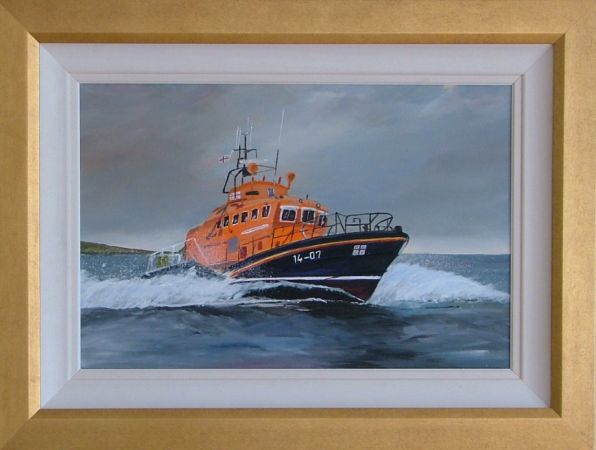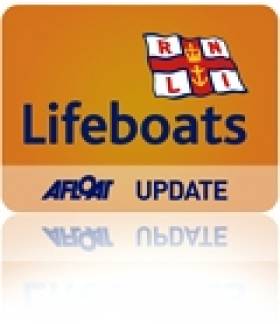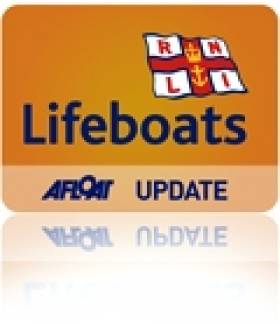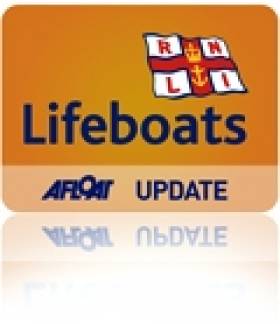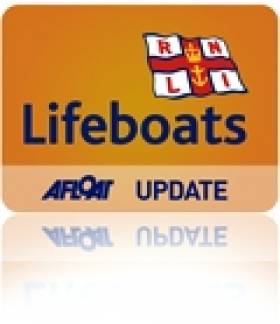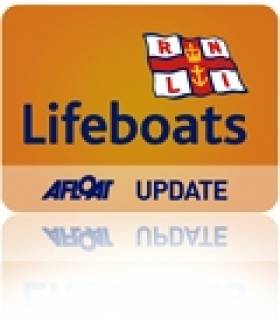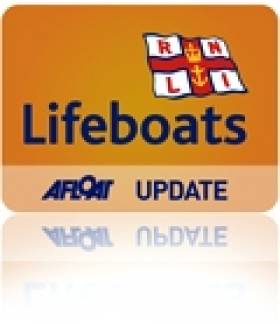Displaying items by tag: RNLI
Dun Laoghaire RNLI's New Inshore Lifeboat Gets First Rescue
The incident occurred shortly after 11.00pm when the pair realised their route off the rocky outcrop at Maretimo was cut-off by the incoming tide since their arrival on foot earlier in the day. The location is a scenic though lesser-known beauty-spot that features a disused Victorian-era harbour as well as other derelict structures.
The new IB1-type Inshore Lifeboat (ILB) was replaced the existing D-Class boat at Dun Laoghaire last Thursday and last night's service was the first
for the new boat that features a larger engine, faster speed and improved navigation capabilities.
Man Dragged from Capsized Dinghy at Newtownards Sailing Club
At around 11.45 this morning Belfast Coastguard received an urgent call for assistance to the Newtownards sailing club where four people were in difficulty, two of them children. One man is unconscious, and in a poor way.
An upside down Lazer 2000 dinghy was spotted by a sailing instructor who went to render assistance to those in the water. The crew of a further incoming rigid inflatable boat also helped.
A man in his 50s was then pulled from the water and brought ashore. He is in a very poor way and cardio pulmonary resuscitation has been administered both in the incoming vessel and ashore. The second adult who had been in the upturned dinghy also assisted. Two children who were also in the water are cold, wet and in a state of shock but otherwise unharmed. All four were wearing lifejackets but the lifejacket on the casualty did not inflate.
The Portaferry inshore lifeboats were launched plus the Bangor Coastguard Rescue Team attended. Local police were also in attendance. An ambulance is also on scene.
Rob Steventon, Watch Manager at Belfast Coastguard said
"Along with the Police we are still gathering further details, but we do not know as yet how long the dinghy had been upturned or how long they had been in the water as the first report was by someone who was going out on to the water and had seen the hull of the craft.
"We urge boaters strongly to check their life saving equipment and general safety equipment to ensure everything is working correctly. The Marine Accident Investigation Branch has been informed."
Communion Class visit Wicklow RNLI
Pupils from 2nd Class of Holy Rosary Girls Primary School visited Wicklow RNLI lifeboat Station on Thursday 10th June. They were greeted by some of the volunteer crew and given a tour of the boathouse and the 2 lifeboats on station, they also had the opportunity to try on some of the kit the crew wear and learn about the role of the RNLI in the local community. As the tour concluded teacher Miss Byrne stepped forward to say the girls had recently made their first holy communion and they would like to donate some of the money they received to Wicklow RNLI.
John Hayden who coordinated the visit accepted the donation from the pupils and thanked them for the generous gesture, saying the money would allow the charity to continue saving lives along the Wicklow Coast.
The RNLI Road Show will be in Wicklow during the sail fest weekend, local Sea Safety volunteer Alan Murphy will be available to give free advice on various aspects of safety including lifejacket maintenance. The road show will be located at the RNLI lifeboat Station.
The Annual Wicklow RNLI Model boat day takes place on Sunday 20th June during the Sail Fest , the venue is the South Quay Shed at Wicklow Harbour from 2pm-5pm , all types of model boats and lifeboats will be on display in a indoor pool , this is a free event and all are welcome.
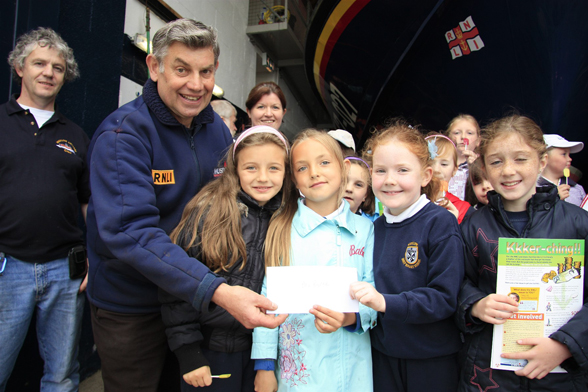
John Hayden of Wicklow RNLI Lifeboat Station accepting the donation from the Holy Rosary pupils - photo RNLI Wicklow
Crosshaven Lifeboat Rescues 18-foot Yacht
Crosshaven RNLI Lifeboat went to the aid of an eighteen foot yacht on passage from the Kinsale area to Crosshaven this evening. The yacht with two persons on board suffered mechanical failure and was having trouble making way into a headwind.
Initially, the yacht was assisted by the motor Cruiser “Callie” who took them on initial tow and informed the Coastguard in Valentia who made the decision to Launch the Crosshaven lifeboat at 7pm. The Volunteer crew made up of Helm Con Crowley with Vincent Fleming and Ritchie Kelleher made their way to the rendezvous between the Cork Bouy and Rennies Point and relieved the motor cruiser of the tow. Crewman Ritchie Kelleher
Boarded the yacht and helped rig the tow for the 40 minute journey back to Crosshaven where the yacht was secured.
Ocean Youth Trust Yacht Lord Rank Sinks off Antrim Coast
The Ocean Youth Trust sail training yacht the Lord Rank sank this morning after hitting rocks off Ballycastle in Co Antrim. Six persons were rescued from the 70-foot ketch in a rescue operation that took just under four hours.
The six, including three Downtown radio presenters, were rescued by lifeboat crews on Tuesday night after hitting rocks near Ballycastle. Those involved were all taking part in a charity fundraiser on board the Lord Rank when the boat ran aground off Kinbane Head shortly after 2200 BST.Downtown Radio was broadcasting from the boat as part of the charity campaign. The six were landed at Ballycastle with no injuries. The Sligo based Irish Coast Guard helicopter also responded to the callout.
Five of the group were taken off the yacht by the Portrush RNLI lifeboat, which launched its Y boat to recover them. The Red Bay RNLI Atlantic inshore lifeboat took the sixth person off before transferring them to the Portrush lifeboat, which then brought them in to Ballycastle.
Paddy McLaughlin, Red Bay RNLI helm said, “ Both Red Bay and Portrush RNLI lifeboats responded to the callout. Our priority was to get everyone off the stranded vessel as quickly as possible as it had hit rocks and the damage to the vessel was not known. That area has a strong tide and we wanted to ensure the safety of the skipper and the five passengers.”The vessel sank a few hours later.
The Lord Rank was Ireland's only operational sail training vessel of any size since the Asgard II sank off the coast of France in 2008.
The BBC article on the sinking is HERE, while the RNLI report of the incident is HERE.
RNLI Seek Volunteers for Docklands Festival
The festival runs as follows:
Friday 1pm – 10pm
Saturday, 10am – 10pm
Sunday 10am – 8 pm
Monday 10am -6pm.
If you’re around on any of these days and have even a few hours to spare, why not come down and help out?
Please email [email protected] to put your name down or contact Aisling on 01 895 1800
Many thanks in advance for your support
Swansea Lifeboat in Multiple Rescues
The warm weather has brought on a string of incidents for Swansea Coastguard, who this afternoon have co-ordinated several rescues, including three missing children, a capsized kayak and an injured jet-skier.
Several resources in particular were sent by Swansea Coastguard to assist in the search for a 5-year-old girl at Burnham-on-Sea beach this afternoon. The girl was reported missing via a 999 call to the Coastguard made by her father at 20 past 2. Swansea Coastguard sent Coastguard Rescue Teams from Burnham-on-Sea and Weston Super Mare, as well as the Burnham Hovercraft, Avon and Somerset Police (including their helicopter), and the two Burnham RNLI inshore lifeboats to perform a shoreline search at Berrow at Burnham-on-Sea.
After an hour-and-a-half of searching the girl was located by Police units who found the girl with a beach warden and returned her safely to her family.
Swansea Coastguard also co-ordinated the searches of a missing 6-year-old girl this morning, also at Burnham, and a missing 5-year-old boy at Rhossili.
In other incidents, a kayaker was rescued by the Mumbles RNLI lifeboat after capsizing and Rhossili Coastguard Rescue Team were sent to the rescue of a female seriously injured in a jet ski incident on the beach at Port Eynon, Gower. The Coastguards assisted paramedics to evacuate the female onto the air ambulance, where she was taken to hospital.
Swansea Coastguard Watch Manager Dai Jones said:
“We have had an extremely busy afternoon, with many incidents brought on by the warm weather. We would like to remind members of the public to be vigilant when taking children to the beach as, on days like this when the beaches are packed with people, it only takes a child to disappear from view for a second before they can become lost.”
Lifeboats Rescue Man Overboard off Antrim Coast
On a busy Sunday for RNLI lifeboat crews off the north Antrim Coast both Red Bay and Portrush RNLI lifeboat crews launched at 9.22am this morning to reports of a vessel in difficulty with two people onboard off Sheep Island at Ballintoy.
The 16 foot fishing boat got into difficulties when an anchor went down and a crewmember from the vessel bent over the bow of the boat in an attempt to retrieve it. He was caught by a wave and pulled into the freezing water.
When the lifeboats arrived on scene the man had been recovered onto the vessel by the other crewmember. Conditions were poor with a force five in evidence and a big swell. Both men were suffering from the cold and were in shock. The vessel was clearly in great difficulty and the two men were transferred onboard the Portrush all weather lifeboat while Red Bay RNLI towed the vessel back to land. A waiting ambulance met the casualties at Ballycastle.

Commenting on the rescue Red Bay RNLI helm Paddy McLaughlin said, “These two men were extremely lucky today. One man had already entered the freezing water before getting back on the boat and they were both in need of medical assistance by the time we had reached them.”
The rescue operation lasted for three hours and was the second major rescue for the RNLI in the area that morning. Portrush RNLI inshore lifeboat crew rescued two men from the sea while their all weather lifeboat assisted Red Bay with the Ballintoy callout.
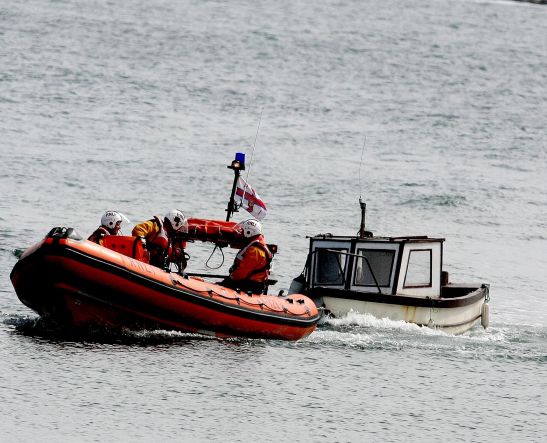
Additional report from MCA:
The emergency 999 call was made at 9.15 this morning alerting the marine emergency service and that the cruiser with two people on board was in extreme difficulty and without power.
The Coastguard immediately relayed a mayday signal into the area to alert other vessels to the on going emergency.
The Portrush and Redbay lifeboats were also asked to launch and a rescue helicopter was initially scrambled from the Royal Naval Air Station at Prestwick, however by this time the man had been recovered to the vessel and it was stood down. His colleagues on board the cabin cruiser indicated that he was very cold but there were no visible injuries and that he was slowly warming up, but they remained without power as a rope had been caught around its propeller and were experiencing very heavy weather. The Portrush all weather lifeboat picked up the man who gone into the water and a colleague and brought them will all speed back to Ballycastle. The Redbay lifeboat is now bringing the vessel under tow back to Ballycastle.
Meanwhile a further call was taken from Portrush promenade where a member of the public had spotted two people in the water shouting for help. Both were drunk and had been caught in the rip tide off West Strand. The Coastguard began broadcasting into the area immediately requesting vessels to go to his assistance and the Portrush inshore lifeboat was on scene very quickly and recovered both people to the lifeboat. An ambulance was requested and the lifeboat was met by the Coleraine Coastguard Rescue Team and paramedics.
Alan Pritchard, Duty Watch Manager at Belfast Coastguard said:
“It is clear that the weather is going to be somewhat rough today with rain forecast. We are asking the boating public and those who will be visiting the coastline to take that extra bit of care. Make sure you have some communication with you, and of course if you go afloat wear a lifejacket! The two men who went into the water whilst under the influence of drink are very poorly in hospital, and we cannot stress enough how dangerous it is going into the sea whilst drinking.”
The charity that saves lives at sea is planning a major event in the city of Derry this Sunday 9 May 2010 at midday. The RNLI want to break the official current record for the number of dancers forming a continuous ‘Riverdance’ line and dancing in unison. The event is being planned to raise funds for the Royal National Lifeboat Institution and to raise awareness of the life-saving work of the volunteer lifeboat crews in Ireland.
The current record stands at 312 dancers and was set in New York in 2008. The RNLI is hoping to break this record and over the past few months organisers have been in contact with Irish dancing schools all over the country. Interest in the event has been enormous and Derry City Council will be providing valuable support in staging the unique performance in the city. Three of the cast of the official Riverdance show will also be coming to take part in the record attempt.
The idea for the record attempt came from RNLI Area Fundraising Manager Tony Hiney after Riverdance selected the RNLI as their chosen charity last year on their Irish tour. “ Seeing that famous line of dancers performing together and the effect it had on the audience gave me the idea of trying to break the record while at the same time trying to raise funds and awareness for the work of the RNLI. You never know how many people will turn out on the day but so far the response have been overwhelming. I really hope we can break the record and raise some funds for the RNLI in the process.”
Each dancer taking part in the record breaking attempt has agreed to raise a minimum of £20/€20 to secure their place in the line. All funds raised will go to the RNLI.
The dancers will be taking their places on Queen's Quay from 11 am on Sunday 9 May.
Art Exhibition in aid of RNLI
Philip O’ Byrne, Cork artist will be holding an art exhibition in aid of the RNLI at the Hall of Frames Gallery, Donnybrook, Douglas from Friday May 14th to Sunday May 16th. The theme of the painting is “From Hook Head to Loop Head” and will include many maritime own works as well as works from other local artists. A painting of the Courtmacsherry lifeboat off the Cork coast and a framed Admiralty chart of Cork to Kenmare will be sold to highest offers in aid of RNLI. There will also be a raffle for your choice of painting by the artist.
The exhibition will be opened by Tom MacSweeney, Marine correspondent on Friday evening at 7:30pm
The RNLI relies on donations and money raised through fundraisers. It costs €1200 to train a volunteer for one year. This art exhibition hopes to raise at least this amount. This is an opportunity to help the RNLI and acquire some art. Prices range from €50 to €500 Any enquiries to Philip O Byrne 087 2646978 or see his popst on the Afloat forum here.
